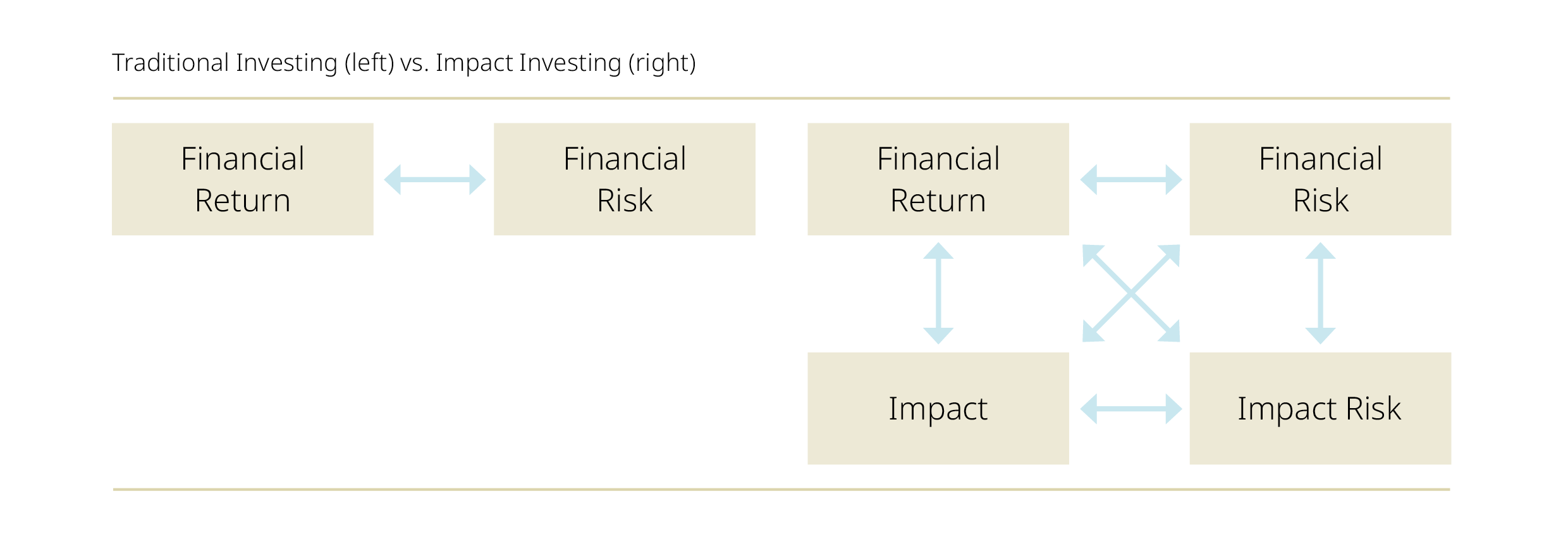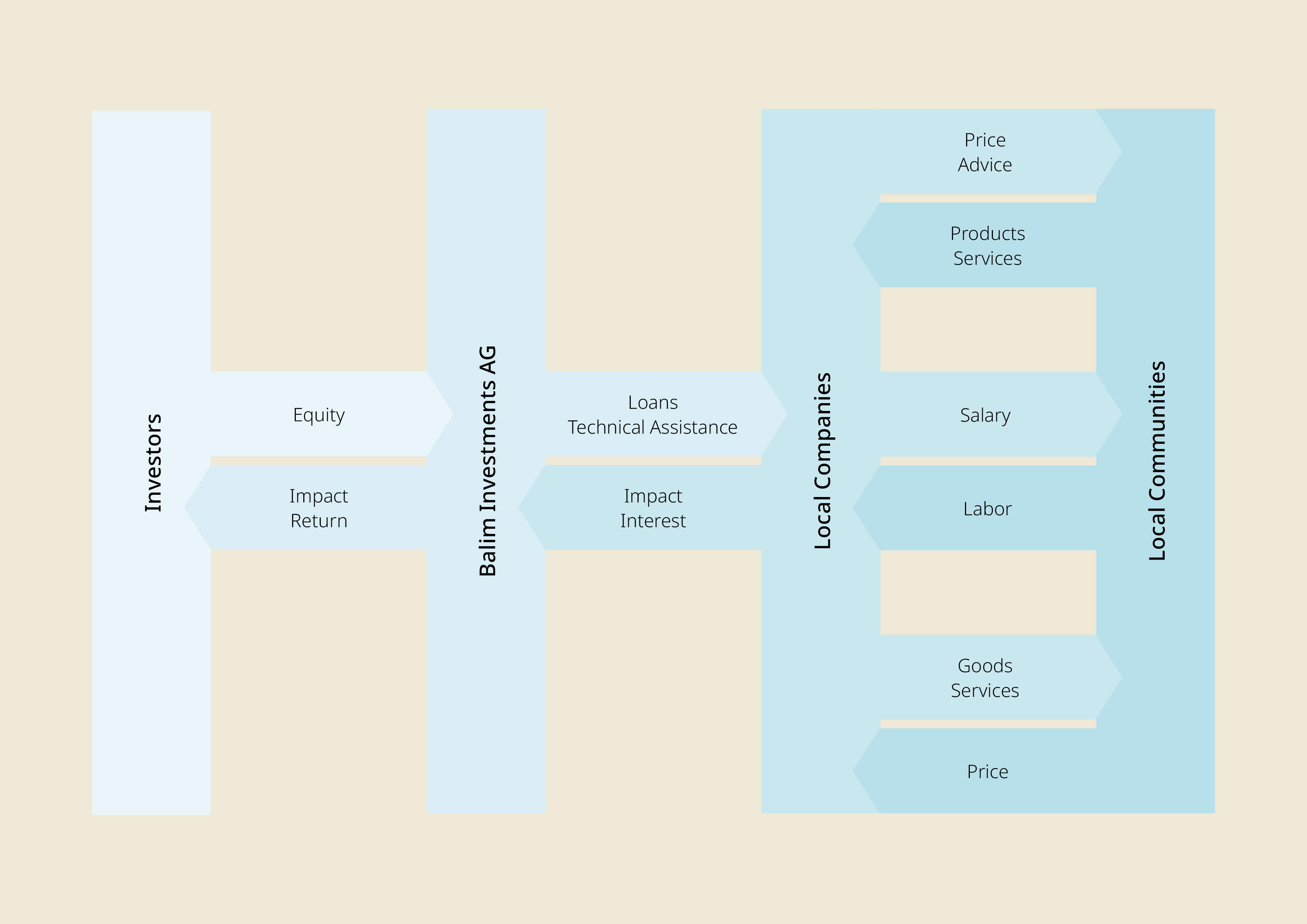Impact investing as a funding method
Somaha Foundation defines impact investing as investments that, in addition to a financial return, generate an impact in line with the foundation's purpose. Together with two partner organizations, Somaha Foundation laid the foundation for the establishment of Balim Investments AG (BALIM).
Impact investing at Somaha Foundation
Traditionally, investments tend to focus primarily on financial objectives, potentially considering some sustainability aspects. The so-called ESG-criteria can serve two purposes:
- As environmental, social or governance risks, that could jeopardize the achievement of financial objectives.
- As exclusion criteria, in the sense that certain projects, companies or even sectors are excluded if the criteria are not met (negative screening).
Traditional investment decisions, including ESG-compliant ones, must weigh the expected financial return against the corresponding risk and liquidity of an investment. Impact investing has a broader objective in that it seeks a concrete, measurable impact (positive screening). This adds two additional aspects that must be weighed when making investment decisions: the expected non-financial return and the impact risk in the form of the statistical dispersion of the impact achieved.
If considering impact is an economically binding constraint on the investment decision, it will reduce the expected financial return (for the same financial risk). However, the reduced financial return is offset by a non-financial return (in the form of impact).
Somaha Foundation seeks impact through impact investing, primarily in the area of combating absolute poverty. Absolute poverty is often the result of a lack of markets or access to markets.
Market failures can also be a cause of poverty, particularly in the form of negative externalities and information asymmetries. Investment can create missing markets, facilitate access to markets or correct market failures by providing affordable capital on transparent and binding terms. As part of an impact investment decision, in addition to financial criteria and alignment with the overall objective, the following questions need to be addressed:
- What impact can be achieved for whom (target group and impact orientation) by changing which economic parameters (price, quantity, quality, etc.)?
- How can unintended effects and spillover losses be avoided (effectiveness and efficiency)?
- How can it be ensured that the intended investment does not crowd out other investments (additionality)?
As part of its funding activities, Somaha Foundation provides its funding partners not only with financial resources, but also with expertise and network of relationships. Similarly, in impact investing, the provision of capital is complemented by technical assistance.
An important funding concept of the Somaha Foundation is localization, this means strengthening local organizations and communities by increasing their independence and self-determination. Impact investing supports this approach by providing local companies with capital they would not otherwise have access to, thereby strengthening them.

Impact investing in practice: BALIM
Together with HEKS and iGravity, Somaha Foundation founded the impact investing vehicle BALIM. Its aim is to strengthen local communities and improve their framework conditions. BALIM finances small and medium-sized enterprises (SMEs) in rural regions of Sub-Saharan Africa with a focus on agriculture.
BALIM aims to have a positive social and environmental impact and to generate a financial return that can be reinvested to support other initiatives in the public interest.
Why does BALIM focus on rural Sub-Saharan Africa?
According to the World Bank's definition, people live in absolute poverty if they live below the defined living wage and are therefore unable to meet their basic needs such as food, housing or clothing. Almost half of the people affected by absolute poverty live in Sub-Saharan Africa.
The poverty rate is generally higher in rural areas than in urban areas. In Senegal, for example, national statistics in 2021 estimated the proportion of people living below the poverty line in urban areas at 19.8%, while this proportion averages 53.6% in rural areas. Most of them work in agriculture. Overall, around 65% of people in East Africa work in agriculture.
Economic impact model of Balim Investments AG

Investors – BALIM
With the aim of strengthening local organizations in their independence and self-determination, HEKS, iGravity, and Somaha Foundation provide equity to BALIM. This should not only serve the purpose of Somaha Foundation and its partners, but also generate a financial return. Besides its role as an investor, iGravity provides services to BALIM. Specifically, iGravity is looking for local SMEs with promising business models, significant relevance to the local community, but without access to adequate funding.
BALIM – Local Companies
BALIM supports these companies with loans and technical assistance and receives interest in return. At the same time, it achieves an impact in line with its purpose.
Local Companies – Local Communities
The companies can develop and grow, engaging in diverse interactions with local communities:
- Typically, these companies process or trade products from local farmers, thereby boosting demand for their agricultural products and creating new market channels. Simultaneously, they provide advice to farmers, enhancing their know-how.
- Moreover, the companies provide labor opportunities, ensuring local communities receive an adequate salary.
- Additionally, the companies sell their products locally, providing communities with access to goods and services, thereby enhancing supply security.
Thus, BALIM has a social impact and generates a financial return.

